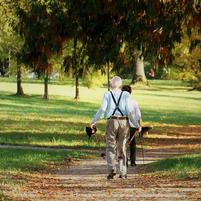For the past three years, I've had the privilege of attending The Longevity Forum's annual conference in November. The event brings together leading figures from the academic, investment and non-profit sectors to think about how enable people to live longer, healthier and more fulfilled lives. This year, the conference was held virtually and spanned an entire "longevity week." Here are five things I learned about innovative trends in aging:
- The promise of AI. The science of ageing isn't just about combatting senescence at the cellular level. It's also about harnessing the power of technology to prolong healthy lives. In this regard, one of the more interesting ideas emerging trends is how artificial intelligence (AI) can enable us to mine medical data in search of patterns. Through the universe of devices (e.g., wearables, smart homes, smart cars, etc.) that monitor things like blood pressure, heart rate, and oxygen levels, we open up entirely new possibilities for diagnostics and treatment of age-related conditions. Moreover, by collecting data on "healthy" bodies, these smart devices also allow us to take better care of ourselves when we're younger, perhaps the best weapon against frailty and disease.
- Consuming Joy. When we think about 'inclusive design' for an ageing demographic, we typically envision things like the 'Good Grips' kitchen implements, initially designed for people with arthritis in mind. But 58% of retirement-age people have no disability whatsoever. And there's an older market out there ready and waiting to, as one panelist put it, consume "joy." As such, The UKRI's Healthy Ageing Challenge - which was set up to invest in products and services to help people remain independent, productive and active into older age - has adopted a much more 'inclusive' approach to inclusive design.
- Investing in Social Infrastructure. Several panelists emphasized the need, for example, to focus on social infrastructure - e.g., the libraries, community centres, high streets - that often go neglected in conversations about inclusive design. This is particularly important in economically deprived areas, which typically lack the gyms, gardens and parks that foster the social engagement that is so crucial in later life. One of the downsides of the longevity dividend is that it can exacerbate health inequalities between the richest and poorest segments of the population. But we cannot expect progress on the socio-environmental dimension of 'ageing in place' to be addressed solely through the social welfare system. One idea that came through loud and clear was that local businesses and NGOs also need to be brought in to support collective solutions.
- Rethinking built design. The UK has the oldest housing stock in the EU; more than one third of homes date to before 1946. These older houses are disproportionately marked by high levels of disrepair, along with ineffective insulation and lower energy efficiency ratings. They are not fit for purpose for the over- 65 demographic who occupies them most: Cupboards can't be reached. Windows can't be opened. Kitchens are poorly lit. Research shows that over-65s don't want their housing "hospitalised." So innovations like floor to ceiling solar windows, moveable walls and pull-out shelving can make a massive difference. The trick is to retro-fit housing for these adaptations long before owners reach 65, and to recognise that not all innovative solutions need to be high-tech.
- Ending Silos. If there were one 'watch word' to emerge from this year's conference, it was 'silo.' Again and again, panellists talked about the need to break down silos in different aspects of the healthy ageing agenda. Designers and architects need to integrate a public health dimension into city planning. National governments need to work with local governments to pursue a more joined-up healthy ageing strategy. Insights from the lived experience of citizens need to be married up with those of professionals. Investors need to join up with social entrepreneurs to fund change at scale.
One panellist observed that the longevity agenda is a lot like the climate change agenda. There's so much we can do, but if we don't act now to capitalise on these emerging trends in innovation, we'll be caught on the back foot. To paraphrase another participant, ageing is the single greatest humanitarian challenge we face. Let's use the tools we have to address it.
About the Author
Delia Lloyd is a Visiting Fellow at the Oxford Institute of Population Ageing. A seasoned writer and editor, she worked for a decade in radio, print and online journalism. Her reporting and commentary have been featured on outlets including The New York Times, The Washington Post, The Guardian and The BBC World Service.
Opinions of the blogger is their own and not endorsed by the Institute
Comments Welcome: We welcome your comments on this or any of the Institute's blog posts. Please feel free to email comments to be posted on your behalf to administrator@ageing.ox.ac.uk or use the Disqus facility linked below.













